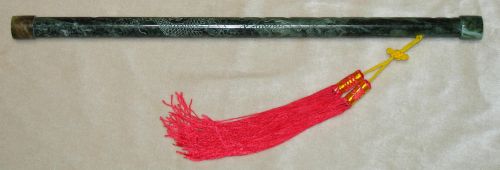
Dizi in D, E, F, and A. The lowest notes of these instruments are, respectively, a', b', c'', and e''.
While very ancient, single-tube Chinese flutes with finger holes have been found—made from the bones of birds or animals, stone, and jade—it seems that the earliest depictions of flutes in China show panpipes (now called paixiao). Pottery figurines of players of end-blown flutes (today called xiao, also spelled hsiao) survive from the Han Dynasty (206 BC–220 AD). Transverse flutes (today called di or dizi) became common later, though some sources state that they, along with the xiao, arrived in China from the western regions during the Han Dynasty.
Chinese flutes have changed significantly over time; different types (with differing numbers of holes and sizes and names) were used in different regions and periods, and the terminology can be confusing. It is only the relatively modern forms of dizi and xiao that I describe here.
An excellent reference on historical Chinese musical instruments is http://www.chineseinstruments.org/.
The generic term for the transverse flute in China today is "di". The most popular traditional type, a bamboo flute with six finger holes and a special hole for a "membrane" between the embouchure and first finger hole, is the dizi. In my understanding, dizi is pronounced vaguely like "dee-tsu", with only a quick touch of an unaccented vowel sound at the end; sometimes it sounds like "dee-tzzz". (The "zi" in "dizi" is a diminutive ending, so that dizi literally means "small di".)

Shown above are four modern, tunable dizi—in D, E, F, and A (from bottom to top). Three of them are signed by the maker—the mark is between the sixth finger hole and the two lowest vent holes. The maker's mark is put on selected, better quality instruments, but the unsigned instrument in the photo (the one in F) happens to play very well anyway.

These instruments use "simple fingering" [click for the chart] and provide a major scale when the fingers are raised one by one. (Though a supporting finger technique is common, with finger hole 5 covered as often as possible, to help support the flute—see here.) They are also expected to be able to play the minor seventh of the scale starting with the lowest note (the six-finger note) with a forked fingering, or by half closing finger hole 1. Thus a dizi with six-finger note D can play both D major and G major scales. It is important to understand that the dizi is named after its three-finger note, the pitch heard when the top three holes (only) are closed by the fingers of the left hand. This is consistent with the traditional notation for written dizi music, where "1" is used for the three-finger note. (One does, however contrary to tradition, find the dizi named after its six-finger note in some modern sources.)

The dizi is strongly diatonic. Though semitones outside the basic scales can be produced by artifice, they are awkward and players would avoid these in performance of traditional music. Dizi players will own several instruments in different sizes, so that they can easily play in several keys.

The traditional songs and instrumental music of China are primarily pentatonic. A dizi whose six-finger note we write as D might only need to use the notes D, E, G, A, B. for such a tune.

But the C# and F# will be used in ornaments or decorations. Shown below is an extract from a written-out suggested performance, taken from Chinese Flute Solos by Jonathan Stock (Schott ED12436, 1994). Proper style requires the flutist to play these or similar decorations. The tongue is used rarely if at all, and the grace notes are often more rhythmic than melodic. Some portamento, achieved by sliding fingers onto or off of their holes, may be used.

Techniques used by dizi players of contemporary compositions will differ. Modern techniques include staccato, flutter tonguing, harmonics, chromatic notes outside the basic scales, and an extended range. Most traditional tunes require a range of only d' to a'' or b'', but two-and-a-half octaves or so may be employed by virtuosi. In the 20th century, special dizi have been made (1) that have no membrane (xindi), (2) with some keys (giajiandi), and (3) with eleven finger/thumb holes (xingzhudi) in order to have a tone hole for every note in the chromatic scale.
The distinctive and unique buzzing tone of the dizi is due to the use of a membrane (dimo) taken from the inner wall of the bamboo plant and fastened over the special hole (mokong) between the embouchure hole and the first finger hole. Traditionally, the glue used is from the herb ejiao. The addition of the mokong has been attributed to Liu Xi in the Tang Dynasty (618-907 AD). By the Ming Dynasty (1368-1644 AD), the membrane-flute had completely replaced the membraneless form in China. The dimo vibrates with the instrument when it is played, and the resulting sound can be rich and penetrating. The adjustment of the dimo is critical [see this video]; if it is not correct, then the buzzing will not be present on all notes, and some notes may not speak at all. It is not to be taut, but more relaxed with a few wrinkles. But more tension will improve the speech of the higher notes.

Dizi are most commonly made of bamboo. They are tightly wrapped with thread at a number of points along the length; this is to prevent or contain cracks. The protective ferrules at each end are of bone, jade, or wood. A poem is inscribed on the long decorative length to the left of the embouchure hole. There are four holes below the sixth finger hole, to act as sounding and venting holes for the lowest note, and the pair of holes on the lower side of the instrument can also be used to attach a decorative tassle.

All but the cheapest modern bamboo dizi are provided with a metal tuning device, and can be disassembled into two parts.



The spacing of the six finger holes on old dizi (early/mid 20th century and before) is more-or-less uniform. On modern dizi the fourth and fifth finger holes, for example, are quite close together; because of this, I find it difficult to cover the right hand holes well on some modern instruments.

This movement of the holes is an attempt by 20th century makers to better match the instruments to western tuning (equal temperament). There are still players who prefer the vintage instruments, but I do not know if there are any dizi makers who attempt to produce replicas of historical instruments with their original tuning.

The scale produced by raising fingers one by one on the vintage dizi consists of intervals between 3/4 tones and whole tones. Many of the thirds are "neutral", i.e. between major and minor thirds. The things I notice most in playing the vintage instrument are (using the terminology of the six-hole flute with low note D) a sharp D, flat F#, flat B, and very flat C# (atually closer to C)—compared with equal temperament. But the instruments sounds fine when playing traditional Chinese tunes, and tends to sound somehow smoother than the equal-tempered modern dizi.
The xiao (pronounced somewhat like "showh", to rhyme with "cow", or "shyow") is an end-blown bamboo flute that is pitched lower than dizi.

Before the Tang dynasty (618–907) the term xiao refered to the Chinese panpipes (paixiao); one ancient name for the xiao is shudi. But after the Tang Dynasty, xiao always means the vertical, end-blow flute. Sometimes the term dongxiao is used. (Dong means hole. Perhaps this term can help to avoid confusion with the panpipes, which has no holes. Dong is the same word as kong, as in mokong.) With rare exceptions, they are made of bamboo, the outside of which is left natural.
The xiao is played vertically. or more accurately at an angle of roughly 45 degrees above horizontal. (It is held too vertically in the photo below, but the shop was cramped.) It is understood to be a more refined instrument than the dizi.

Modern xiao have six or eight holes (the eight-hole version is more modern, dating from the 1930s) for fingers and the left hand thumb, plus four vent holes at the bottom that always remain open. There is no mokong or membrane. The six-hole xiao is fingered almost exactly like the dizi, except that the six holes are to be covered with the left hand thumb, LH1, LH3, RH1, RH2, and RH4. The eight-hole xiao has the same six holes, but two additional finger holes, for LH2 and RH3, that sound two new notes.

Xiao from the early 20th century often have five more-or-less evenly spaced finger holes on top of the instrument, quite a difference from these more modern instruments.
The xiao is often classified as a "notched flute", but this can be misleading. The vast majority of notched flutes have the mouth end of the tube completely open, and a notch carved into the rim at one point, while the mouth end of the xiao is mostly closed; see the photo below. An embouchure is carefully cut into part of the closed end and the adjacent tube. Cf. the embouchure of the Giorgi flute.

A short and thicker version of the xiao (the nanyin dongxiao) with both ends completely open and the root of the bamboo at the bottom is the ancestor of the Japanese shakuhachi.
While the xiao has a mellow and graceful sound in general, some are made of thinner bamboo and have a quieter sound—well suited to play in duet with the guqin (plucked zither)—and these may be called qinxiao. The middle instrument in the photo of three xiao above is of this type.
See this link
for fingering charts for both the six- and eight-hole xiao.
An interesting video Chinese Traditional Music-Bamboo Flute(DiZi) includes qudi (low pitched dizi), xiao, bangdi (high pitched dizi), and paixiao. The differences in the instruments are very clear.